Global Employment Trends for Youth 2017: Paths to a better working future
Incorporating the most recent employment trends for young women and men, Global Employment Trends for Youth sets out the youth labour market situation around the world. It shows where progress has or has not been made, updates world and regional youth labour market indicators, and gives detailed analyses of medium-term trends in youth population, labour force, employment, unemployment, working poverty and informality.
The 2017 edition discusses the implications of technological change for youth labour market prospects – both quantity and quality – focusing on trends in sectoral employment and on the forms of work available to young people.




